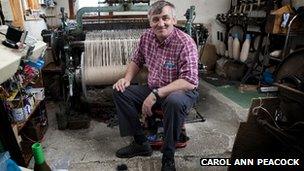Harris Tweed: Weaving a brighter future
- Published
The fashionable rise of Harris tweed
One of the bigger problems in trying to sell Harris Tweed is that it is so durable.
Once a chap's got one jacket, he's unlikely ever to need a replacement.
And that factor is what nearly made the industry itself much less durable than its own output.
Five years after it came close to a sales meltdown, it's back and growing. Between 2009 and last year, production more than doubled - from 450,000 metres of cloth to more than one million.
That is the highest output for 17 years.
There is still a long way to go before returning to the seven million metre high point in 1966.
Brian Wilson, the former Labour government minister who is closely involved with the industry's turnaround, says he is not in a rush to do so.
He doesn't have "imperial ambitions". It's better to have 200 people in sustainable jobs, he argues, than to have up to 400 people returning to the uncertain job prospects they faced in the past.
Exporting people
The economy of Harris and Lewis has long been among the most fragile in Britain, and its fortunes were closely tied to those of the weaving industry. With poor prospects for jobs, it has led to long-term population decline.
Through the second half of last century, the number of people on Harris fell by half, to below 2,000. And beyond the short and fickle tourist season, there remain limited prospects for retaining its young people.
So while emigration has been the island's main export, tweed has given it a worldwide reputation.

Ben Affleck wore Harris Tweed when playing Tony Mendez in the film Argo
It was one of the first products to enjoy legal protection of its geographical status.
From 1909, a law was in place that meant the Harris Tweed logo, an orb, could only be used if the material had been spun, dyed and hand-woven on the islands of the Outer Hebrides.
The size of most of the looms in use has recently been increased, but the foot-pedalling and traditional methods of weaving have been unchanged for generations.
By the high point of production in the 1960s, Harris Tweed had established itself as a world class brand.
Only recently, the man whose CIA exploits in Iran inspired the movie Argo let slip that the Harris Tweed jacket was the uniform for those in-the-know when US spies were operating behind the Iron Curtain.
'Young and versatile'
Its more fashionable resurgence has seen it featured in the Karl Lagerfeld and Chanel collection last December, when the Paris-based designer chose to highlight Scottish textiles in his annual artisan show.
It is also included in mass-produced garments for the high street, and it's being used for upholstery, fashion accessories, handbags and footwear, including Dr Martens' boots.

A model wearing Harris Tweed designed by Judy R Clark in New York
Brian Wilson says: "We've been lucky, in that fashion trends were towards heritage, quality and provenance. We tick those boxes.
"We've also made our luck, completely remodelling the image of Harris Tweed. It's no longer an old man's jacket fabric. It's young and versatile.
"One of the first things we did was work with young Scottish designers, and people began to see Harris Tweed as they'd never seen it before."
Mr Wilson, whose ministerial career included responsibility for trade, recalls: "We went to the States. We got clients like Rag & Bone, Theory and JCrew. Once you get these people on board, you get a cascade down to bigger volume. And the same in Britain and Europe.
"You'd never keep this going on orders from the top design houses, but it gives a fantastic cache if they're using it."
Along with that came a big boost from the Japanese market, which has overtaken Germany and the US to become the biggest export market.
Cutting patterns
Donald John Mackay has been weaving through the 40 years of decline, and was among those credited with turning it around.
He was one of the first to secure the move to new uses for Harris Tweed, when Nike ordered 9,000 metres of his design to include in a range of its shoes. His contribution to the industry has since been recognised in the Honours List.
He works at his shed beside his home in Luskentyre, Harris. And he argues that the decline was due to an ageing workforce, the market shrinking and a failure to market it.
It wasn't the product at fault, he says. "It was just that people didn't know about it, perhaps."

Donald John Mackay is one of those credited with turning around the fortunes of Harris Tweed
The decline was accelerated following the sale of the main mill, in Stornoway on Lewis, to Yorkshire businessman Brian Haggas. He cut the number of patterns from several thousand to only four, intended solely for the gents' jacket market.
The self-employed weavers, who have for generations worked at sheds on their crofts to supplement meagre earnings from agriculture, could see little future in that.
Brian Wilson was part of the Harris Tweed Hebrides consortium that bought a mothballed tweed mill at Shawbost, on the west coast of the Isle of Lewis.
In 2008, two years after Mr Haggas began to implement his strategy, the new rival began production. It now controls around 90% of the market.
Mr Wilson, executive chairman of Harris Tweed Hebrides, recently picked up two of the top trophies at the UK Fashion and Textiles Awards.
With the better prospects for Harris Tweed, the third and smallest mill, at Carloway on Lewis, recently attracted Chinese investment.
Hand-made, home-made
The growth in demand has ensured there's also a demand for more weavers. At present, there are about 150 self-employed islanders who weave at their homes. Most are in Lewis. There are a further 125 people working in the three Lewis mills and at the Harris Tweed Authority, set up by law to protect its status.
Most of the weavers supply the mills, while a few are independent, designing their own fabrics, often for the craft market.
Twenty-two young islanders have been put through a training course, and more are being sought.
One of the graduates is Heather MacLeod, 22, from Tarbert on Harris. She is the granddaughter of a weaver, and observes: "There's a need for younger weavers to take up the trade.
"There's a lot of people going back to doing home industries - candle-making, soap-making. These are companies that are thriving just now and everybody is looking for things that are hand-made and home-made.
"It's coming back, and there are plenty opportunities for people."
You can hear more about Harris Tweed and the Isle of Harris economy in Business Scotland, on BBC Radio Scotland, on Sunday 9 June at 10:00. It's also available on BBC iPlayer and by free download.
- Published10 April 2013
- Published9 April 2013
- Published24 December 2012
- Published11 March 2013